National industry
National industry changes -0.1% in February; reaches fifth consecutive month without growth
April 02, 2025 09h00 AM | Last Updated: April 02, 2025 03h17 PM

The sector of pharmochemicals and pharmaceuticals (-12.3%) was the major responsible for the negative performance of industry in February - Picture: Rodrigo Nunes/ASCOM-MS
The Brazilian industrial output changed -0,1% between January and February. The reduction in the pace occurs after a null change (0.0%) registered in the previous month, when it interrupted three consecutive months of negative rates, a period in which it accumulated a loss of 1.2%. The industrial output grew 1.5% in relation to February 2024, the ninth positive figure in a row. In the year, it accumulates a rise of 1.4% and, in 12 months, an expansion of 2.6%. With these results, industry is 1.1% above the pre-pandemic level (February 2020) and 15.7% below the peak of the time series, obtained in May 2011. The data are from the Monthly Survey of Industry (PIM Brazil), released today (2) by the IBGE.
"The negative performance of industry in February reinforces the lower intensity of the industrial output over the last months. It is the fifth consecutive month without any growth, with a cumulative loss of 1.3% in this period, offsetting the advance of 1.0% recorded in the months of August and September 2024. Moreover, negative rates are widespread in February. The loss of dynamism in industry is related with the reduction of the confidence level of families and entrepreneurs, explained, to a great extent, by the monetary tightening (with the increase in the interest rate from September 2024 onward), currency devaluation (pressing production costs) and rise in inflation (especially of food products, which impacts on the available income of families)," explains André Macedo, Manager of PIM Brazil.
Between January and February, two out of four broad economic categories and 14 out of 25 industrial sectors surveyed dropped their output. The major negative influences came from pharmochemicals and pharmaceuticals (-12.3%), machinery and equipment (-2.7%), wood products (-9.6%), miscellaneous manufacturing (-5.9%), motor vehicles, trailers and bodies (-0.7%), electrical machinery and apparatus (-1.4%), computer equipment, electronic and optical products (-1.5%) and furniture (-2.1%).
Accounting for the biggest negative impact on the month´s result, the sector of pharmochemicals and pharmaceuticals (-12.3%) interrupted two consecutive months of expansion, a period in which it accumulated a gain of 7.1%. "The drop in the pharmaceutical industry can be explained by the volatility of the results, which is a characteristic of the sector, lower number of days worked due to the grant of collective vacation in some industrial plants, and by a higher comparison basis, due to the advances reported in January 2025 (4.5%) and December 2024 (2.5%), with a cumulative gain of 7.1% in this period," states Macedo. He reminds that "the activities of machinery and equipment, wood products, miscellaneous manufacturing and motor vehicles retreated once again after advancing in the previous month. Except for wood products, the others offset part of the growth registered in January 2025."
Among 11 activities that rose their output, mining and quarrying industries (2.7%) and food products (1.7%) exerted the major impacts in February 2025. The first one offset the drop of 2.5% recorded last January, and the latter reported the third consecutive month of growth in the production, a period in which it accumulated a rise of 4.0%.
The sectors of chemicals (2.1%), pulp, paper and paper products (1.8%), rubber products and plastic material (1.2%) and other transportation equipment (2.2%) significantly advanced as well.
Concerning the broad economic categories, still comparing with January, the sectors of durable consumer goods (-3.2%) and semi and non-durable consumer goods (-0.8%) showed higher negative rates, offsetting part of the growth registered in the previous month (3.8% and 3.2%, respectively).
On the other hand, the sectors of capital goods (0.8%) and intermediate goods (0.8%) reached positive figures in February 2025, the former record the second consecutive month of expansion in the production, accumulating a gain of 3.2%, and the latter offsetting part of the drop of 1.6% reported in the previous month.
Industrial activity rises 1.5% in the inter-annual comparison
Compared with February 2024, industry grew 1.5%, with positive results in three out of four broad economic categories, 15 out of 25 sectors, 50 out of 80 groups and 55.0% of 789 products surveyed. The major positive influences came from motor vehicles, trailers and bodies (13.3%), machinery and equipment (11.9%) and chemicals (5.0%).
the sectors of basic metals (3.7%), textiles (11.7%), electrical machinery and apparatus (6.8%), maintenance, repair and installation of machinery and equipment (10.2%), fabricated metal products (5.1%), rubber products and plastic material (3.9%), furniture (11.6%), other transportation equipment (9.4%), and manufacture of wearing apparel and accessories (6.2%) also contributed positively to the result.
"Despite being the ninth consecutive rise, the magnitude of the advances clearly reduced, though the widespread profile of positive rates remains among the economic categories and industrial activities surveyed. It should be highlighted that this month was influenced by the calendar effect, since February 2025 had one more business day (20) than the same month a year ago (19). However, a higher comparison basis than that recorded in previous months is noticed, since the industrial sector grew 5.6% in February 2024," notes Macedo.
On the dropping side, coke, petroleum products and biofuels (-4.3%) and mining and quarrying industries (-3.2%) exerted the biggest influences on the composition of the industry average. It was mainly due to a smaller production of diesel fuel in the former case, and of crude petroleum oil and iron ore in the latter. The segments of beverages (-6.6%), pulp, paper and paper products (-5.4%) and wood products (-10.4%) completed the group of activities with negative performance.
More on the survey
PIM Brazil has been producing short-term indicators since the 1970s regarding the behavior of the real product of mining and quarrying and manufacturing industries. March 2023 marked the beginning of the release of the new time series of monthly indexes of the industrial production, after a redesign to update the sample of activities, products and informants; create a new weighting structure of the indexes based on the most recent industrial statistics; update the base year of reference of the survey; and incorporate new Federation Units in the release of regional results of the survey. These methodological changes are required and aim at incorporating the economic transformations of the society.
The next release, related to March 2025, will be on May 7. The survey results can also be consulted at the Sidra database.




















